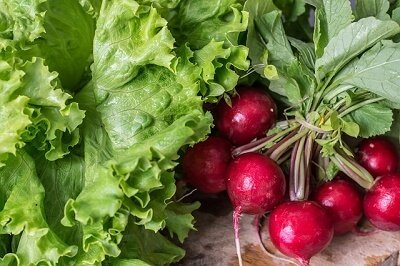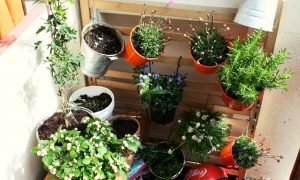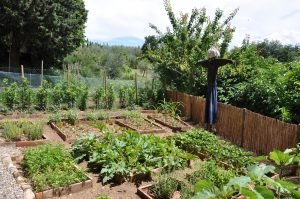This post may contain Amazon® product affiliate links. We may receive a commision if you make a purchase after clicking on one of these links but at no cost to you. Please visit Our Disclosure Page for more information. Thank you.
 The best spot for your garden will depend on your growing style, whether or not you plan on using grow lights, the type of grow lights you use and how much space you have to work with. Growing vegetation indoors can be a fun and exciting way to enjoy your favorite produce year round. But even this type of gardening is not without challenges. Trial and error can be a major part of gardening indoors, especially when it comes to placement and potting options. You will also need to spend more time maintaining your garden, otherwise the mess can quickly get out of hand.
The best spot for your garden will depend on your growing style, whether or not you plan on using grow lights, the type of grow lights you use and how much space you have to work with. Growing vegetation indoors can be a fun and exciting way to enjoy your favorite produce year round. But even this type of gardening is not without challenges. Trial and error can be a major part of gardening indoors, especially when it comes to placement and potting options. You will also need to spend more time maintaining your garden, otherwise the mess can quickly get out of hand.
Preparing for a Long Winter
 Lighting is paramount when it comes to gardening indoors. Without enough light your plants will grow weak, thin and tall, if they grow at all. In winter, even when they’re grown in a sunny windowsill, plants often struggle. For the best results, you must use grow lights to supplement natural sunlight. There are several types of grow lights to choose from ranging in effectiveness and cost.
Lighting is paramount when it comes to gardening indoors. Without enough light your plants will grow weak, thin and tall, if they grow at all. In winter, even when they’re grown in a sunny windowsill, plants often struggle. For the best results, you must use grow lights to supplement natural sunlight. There are several types of grow lights to choose from ranging in effectiveness and cost.
While using a timer really isn’t a requirement for gardening indoors, it does help to make life a little easier. For healthy and strong development, all plants need sleep, just like people. You can use a timer to automatically switch off your grow lights, which in turn will save you the trouble of having to remember to do so.
In order to facilitate air circulation around your plants, use a fan. Using a small fan will help prevent such problems as garden pests and leaf fungi, while also keeping the air moving and smelling fresh.
Take the time to research, plan and design. Sketch out how you want your growing area to look and consider what type of equipment you’ll need to get the job done. If this is your first indoor garden, then start off small. You’ll be surprised to learn just how much care and maintenance even a small indoor garden needs in order to thrive.
Best Plants to Grow Inside
 Gardeners who have experience with growing indoors often recommend starting your own plants from seeds as opposed to using outdoor transplants. This helps to reduce the chances of bringing in pests or disease. Once a type of garden pest catches hold of a plant, they can be almost impossible to get rid of.
Gardeners who have experience with growing indoors often recommend starting your own plants from seeds as opposed to using outdoor transplants. This helps to reduce the chances of bringing in pests or disease. Once a type of garden pest catches hold of a plant, they can be almost impossible to get rid of.
Select a sunny spot for your indoor vegetable garden, using a south facing window if possible. A southwest or southeast location will work as well. If you don’t have a sunny area in your home then you’ll need to purchase indoor grow lights, in order to provide your plant life with the vital sunlight it needs to thrive.
When using a grow light, it can be hung over your indoor vegetable garden area or you can set them on supports. You’ll want the lights to be around six to eight inches above the plants. To ensure your plants are getting the right amount of lighting you can use timers, which come in either regular hand settings or digital. Timers can be purchased at home improvement stores, where you’ll also find indoor grow lights.
Veggies that Thrive in the Winter Months
 So what seeds should you plant? For most indoor setups, herbs, greens and other types of leafy plants will grow the best. Some of the more popular selections include cabbage, broccoli, endive, kale, cauliflower, spinach, mustard greens, lettuce and chard. For herbs, try catnip, dill, lavender, chamomile, lemongrass, basil, chives, oregano, cilantro, sage, rosemary, stevia, mint and thyme.
So what seeds should you plant? For most indoor setups, herbs, greens and other types of leafy plants will grow the best. Some of the more popular selections include cabbage, broccoli, endive, kale, cauliflower, spinach, mustard greens, lettuce and chard. For herbs, try catnip, dill, lavender, chamomile, lemongrass, basil, chives, oregano, cilantro, sage, rosemary, stevia, mint and thyme.
Most likely, you’ll find some success growing these plants, but that doesn’t mean you can’t try your hand at growing more complicated vegetation such as peas or peppers. Experimenting is actually what makes indoor gardening a real pleasure. Just keep in mind that certain fruit bearing plants will not grow as well inside as they would outside. They will also require extra attention, especially when it comes to pollination. Without the exposure to natural methods of pollination such as wind and bees, the plants will not be able to fruit without some help.
For the best indoor grow environment, keep the grow lights on for a minimum of fourteen hours a day. You may need to experiment with longer grow time hours. As far as temperature goes, most plants will grow well in temps that range from 60 to 75F.
Final Indoor Growing Tips
 Be sure to select veggies that have shorter days to harvest. Veggie varieties that grow well in small containers will thrive indoors.
Be sure to select veggies that have shorter days to harvest. Veggie varieties that grow well in small containers will thrive indoors.
Baby greens and micro greens are excellent choices for indoor vegetable gardens. These plants are harvested while young and will only take three weeks to harvest.
When planting veggies, they’ll need at least four to five inches of root space, so any type of container with enough depth can be used.
If you decide to use vermiculite or gravel for your garden then you’ll need to water your plants at least twice a day with a nutrient mixture, which will keep them medium moist.
A potting soil will hold the most moisture for plants and it the best method to use for your indoor garden. Potting soil is also preferred for growing salad mixes and micro greens. After you have harvested your salad mixes you can put the soil mixture in a compost pile and begin a new flat of greens.
Be sure to avoid using garden soil for an indoor veggie garden. This type of soil is too heavy and will compact if used in a container.
Over watering a garden is the most common cause of death for indoor plant life, followed by under watering. The drier the air is the more a plant will need water. A plant will need less water during the colder months, as most plants tend to go dormant. Always let the soil become slightly dry to the touch between watering. An actively growing plant will need to be fertilized every two to four weeks. If you have good potting soil you can usually go longer between fertilizing.
